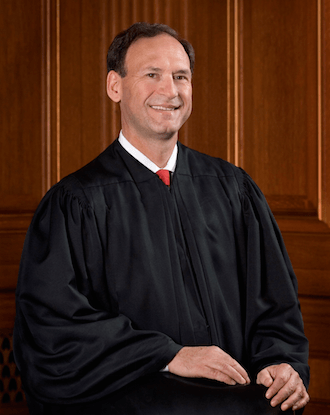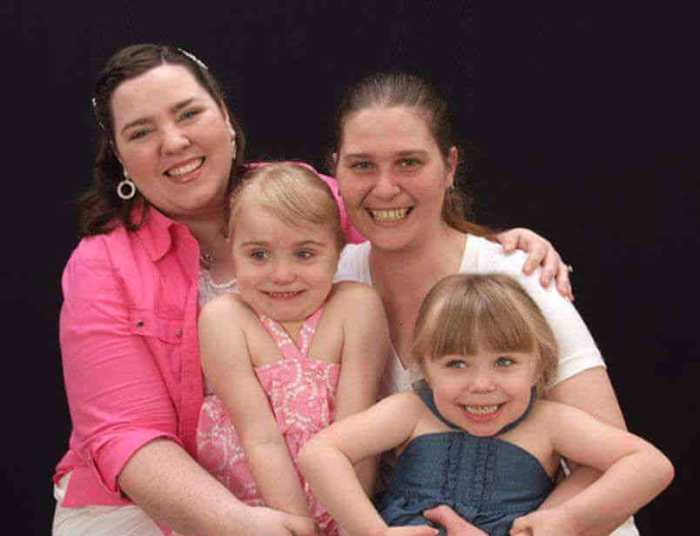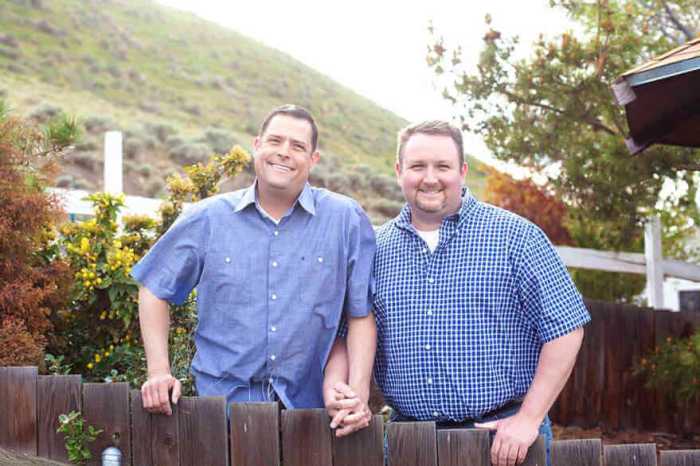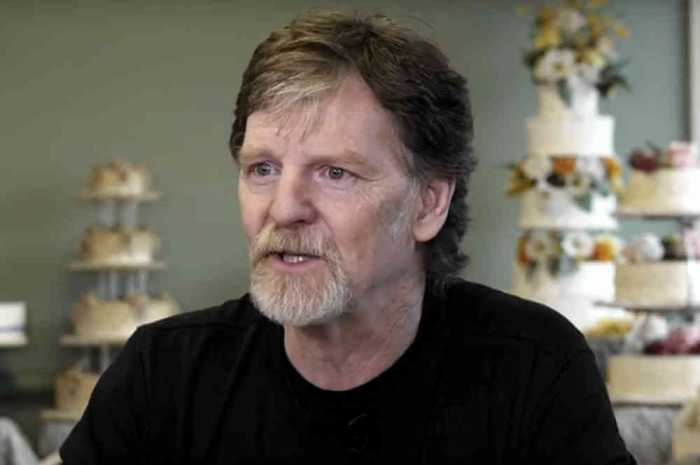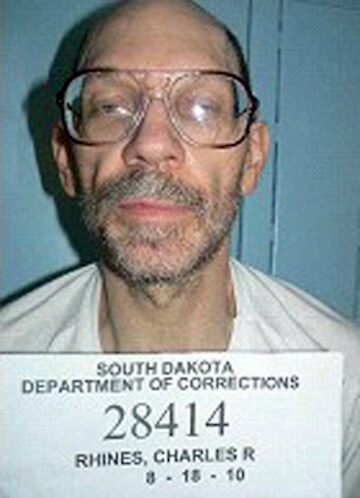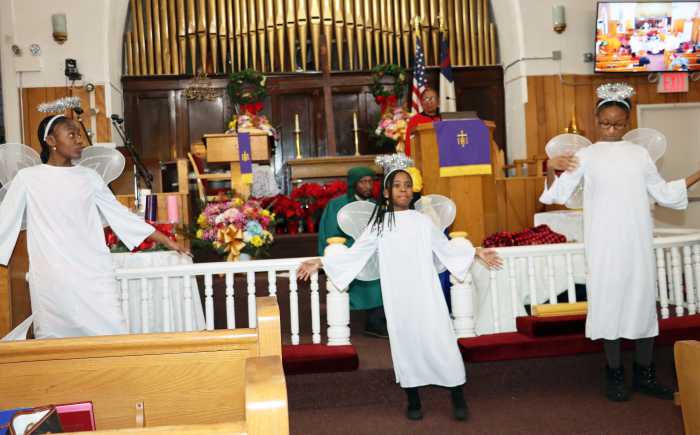Justice Anthony Kennedy. | US SUPREME COURT
The Supreme Court ruled today that “same-sex couples may exercise the right to marry” and that “there is no lawful basis for a State to refuse to recognize a lawful same-sex marriage performed in another State on the ground of its same-sex character.”
Writing for the court, Justice Anthony M. Kennedy, Jr., grounded these marital rights in the 14th Amendment’s guarantee that no state may deprive any person of “liberty” without due process of law or deny to any person the “equal protection of the laws.”
He saw the claimed rights in this case as logical extensions of the rights recognized by the court through his opinions in United States v. Windsor (2013), which struck down the major portion of the Defense of Marriage Act, and Lawrence v. Texas (2003), which invalidated the nation’s remaining sodomy laws.
In four rearguard dissents, the court's minority sounds bitter tone
By fitting coincidence, the opinion was issued on the second anniversary of Windsor and the 12th anniversary of Lawrence.
Kennedy was appointed to the court by President Ronald Reagan in 1987, but his opinion was joined by the four justices appointed by Democratic presidents –– Ruth Bader Ginsburg and Stephen Breyer (appointed by Bill Clinton) and Sonia Sotomayor and Elena Kagan (appointed by Barack Obama).
Chief Justice John Roberts and Justices Antonin Scalia, Clarence Thomas, and Samuel Alito all wrote dissenting opinions for themselves, and each of them also signed one or more of the other dissenting opinions.
The court had granted petitions filed by the plaintiffs in cases from Ohio, Michigan, Tennessee, and Kentucky. In each of those states, federal district courts had, during 2014, ruled either that state laws refusing to recognize same-sex marriages contracted in other states violated equal protection rights or that the refusals of the states to allow same-sex couples to marry violated due process and/ or equal protection rights.
Those rulings were consolidated for appeal before the Sixth Circuit Court of Appeals in Cincinnati, which in November reversed the trial courts in an opinion by Circuit Judge Jeffrey Sutton.
Sutton held that the US Supreme Court’s ruling in 1972 that a challenge to the Minnesota ban on same-sex marriage did not present a “substantial federal question” remained binding as precedent on lower federal courts.
Sutton also went on to reject the plaintiffs’ constitutional arguments, opining that the question whether same-sex couples could marry or have their marriages recognized was one to be resolved through the democratic process, not through litigation.
In granting the plaintiffs’ petition to review that ruling, the Court ordered argument on two questions: whether same-sex couples have a right to marry, and whether states are obligated to recognize same-sex marriages.
A majority of the Court has now answered both of those questions in the affirmative.
This outcome was widely predicted because of the court’s behavior since October 2014, when it declined to review pro-marriage equality decisions by the Fourth, Seventh, and 10th Circuits, lifting stays and allowing marriage equality rulings to go into effect in Virginia, Indiana, Wisconsin, Oklahoma, and Utah, and eventually in all the other states in those circuits. When the Ninth Circuit ruled for marriage equality, the Supreme Court rebuffed every request by state officials in that circuit to delay marriage equality rulings going into effect. The court subsequently refused to stay marriage equality rulings from Florida and Alabama, even though the 11th Circuit had not yet ruled on those two states’ appeals.
The denial of the Alabama stay, weeks after the Court had granted review of the Sixth Circuit’s decision, decisively confirmed that there was a majority for marriage equality on the Supreme Court, to the consternation of Justice Thomas, who made his views known in his dissent from the denial of Alabama’s request for a stay.
The outcome of this case, then, was highly anticipated, so the main questions arousing speculation involved what constitutional theories the court would use to strike down the bans and whether an additional member of the court — most likely Chief Justice Roberts — would join the majority.
Roberts, however, stayed put with his fellow conservative brethren.
Justice Kennedy’s Opinion for the Court
Kennedy’s opinion took a route that could have been predicted based on his opinions in Windsor and Lawrence. His preferred approach in gay rights cases –– leaving aside his first such opinion, in Romer v. Evans, the 1996 case that overturned an anti-gay ballot initiative in Colorado, which is really in a class by itself –– is to rely heavily on his broad conception of liberty protected by the due process clause.
Kennedy began with a quick review of the circumstances facing some of the plaintiffs, showing the deprivations they faced by not being allowed to marry or have their marriages recognized.
He next presented an historical overview of the changing nature of marriage, writing, “Changed understandings of marriage are characteristic of a Nation where new dimensions of freedom become apparent to new generations, often through perspectives that begin in pleas or protests and then are considered in the political sphere and the judicial process. This dynamic can be seen in the Nation’s experiences with the rights of gays and lesbians.”
After reviewing the growing recognition of gay rights by the courts and referring to a friend of the court brief filed by the American Psychological Association, he wrote, “Only in more recent years have psychiatrists and others recognized that sexual orientation is both a normal expression of human sexuality and immutable.”
This could have been a key statement for a holding that sexual orientation is a “suspect classification” for equal protection purposes –– requiring that any law making distinctions based on that category be subjected to a heightened level of judicial scrutiny –– but Kennedy never followed up along that line.
Due Process Issues
Instead, he turned to a due process analysis, and grounded his conclusion on “four principles and traditions” which he said “demonstrate that the reasons marriage is fundamental under the Constitution apply with equal force to same-sex couples.”
The first of those principles “is that the right to personal choice regarding marriage is inherent in the concept of individual autonomy.”
The second is “that the right to marry is fundamental because it supports a two-person union unlike any other in its importance to the committed individuals.”
The third is “that it safeguards children and families and thus draws meaning from related rights of childrearing, procreation, and education.”
Finally, he wrote, “This Court’s cases and the Nation’s traditions make clear that marriage is a keystone of our social order.”
Discussing these four principles, Kennedy penned eloquent explanations that play into the themes he previously developed in his opinions in the DOMA and sodomy cases. For example, he wrote, “The nature of marriage is that, through its enduring bond, two persons together can find other freedoms, such as expression, intimacy, and spirituality. This is true for all persons, whatever their sexual orientation.”
Speaking about marriage’s “support” for the “two-person union,” he wrote, “Marriage responds to the universal fear that a lonely person might call out only to find no one there. It offers the hope of companionship and understanding and assurance that while both still live there will be someone to care for the other.”
After observing that “hundreds of thousands of children are presently being raised” by same-sex couples, he wrote: “Without the recognition, stability, and predictability marriage offers, their children suffer the stigma of knowing their families are somehow lesser. They also suffer the significant material costs of being raised by unmarried parents, relegated through no fault of their own to a more difficult and uncertain family life. The marriage laws at issue here thus harm and humiliate the children of same-sex couples.”
In explaining why the right to marriage is a fundamental right, Kennedy observed, “States have contributed to the fundamental character of the marriage right by placing that institution at the center of so many facets of the legal and social order. There is no difference between same- and opposite-sex couples with respect to this principle.”
Kennedy spoke to society’s changed understanding of same-sex relationships.
“The limitation of marriage to opposite-sex couples may long have seemed natural and just, but its inconsistency with the central meaning of the fundamental right to marry is now manifest,” he wrote. “With that knowledge must come the recognition that laws excluding same-sex couples from the marriage right impose stigma and injury of the kind prohibited by our basic charter.”
Several times in the course of this part of his opinion, Kennedy referred to the “dignity” of same-sex couples being denied or disparaged by denying them the right to marry.
Equal Protection Issues
Turning to the Equal Protection Clause as an alternative source of the marriage right, Kennedy avoided any explicit pronouncement about whether sexual orientation discrimination claims should be subject to heightened scrutiny.
Actually, there are two different strands of equal protection theory: the classification strand and the rights strand. Under the first, the court asks whether the challenged law creates a classification that is “suspect” and thus subject to heightened or strict scrutiny.
Under the second, the court asks whether the challenged law discriminates concerning a fundamental right, and thus will be struck down unless the government proves a compelling justification.
Kennedy focused on the second strand.
Referring back to the court’s earlier marriage cases, he wrote, “The equal protection analysis depended in central part on the court’s holding that the law burdened a right of ‘fundamental importance.’ It was the essential nature of the marriage right… that made apparent the law’s incompatibility with requirements of equality.”
He emphasized the interconnectedness of the liberty/ due process and equal protection theories, referring to his 2003 opinion in the Texas sodomy case, Lawrence v. Texas.
“Lawrence therefore drew upon principles of liberty and equality to define and protect the rights of gays and lesbians, holding the State ‘cannot demean their existence or control their destiny by making their private sexual conduct a crime,’ he wrote. “This dynamic also applies to same-sex marriage. It is now clear that the challenged laws burden the liberty of same-sex couples, and it must be further acknowledged that they abridge central precepts of equality. Here the marriage laws enforced by the respondents are in essence unequal: same-sex couples are denied all the benefits afforded to opposite-sex couples and are barred from exercising a fundamental right. Especially against a long history of disapproval of their relationships, this denial to same-sex couples of the right to marry works a grave and continuing harm. The imposition of this disability on gays and lesbians serves to disrespect and subordinate them. And the Equal Protection Clause, like the Due Process Clause, prohibits this unjustified infringement of the fundamental right to marry.”
In the ongoing dispute over whether the plaintiffs were claiming a new constitutional right of “same-sex marriage” or access to an existing fundamental right to marry, the court, then, has adopted the broader view.
Who Should Decide?
Kennedy rejected the states’ argument that this decision was being made without sufficient “democratic discourse,” pointing out that same-sex marriage has been a topic of debate for decades, and asserting that “there has been far more deliberation than this argument acknowledges,” referencing referenda, legislative debates, “countless studies, papers, books, and popular and scholarly writings.” Indeed, he pointed out, “more than 100 amici” had filed briefs with the court presenting a wide range of perspectives on all sides of the issues.
And, he pointed out, “the Constitution contemplates that democracy is the appropriate process for change, so long as that process does not abridge fundamental rights.” Having found that the marriage bans abridge fundamental rights, he concluded judicial action was justified: “The dynamic of our constitutional system is that individuals need not await legislative action before asserting a fundamental right.”
Kennedy also rejected the argument that the Court should refrain from this ruling because of possible adverse impact on traditional marriages, finding that the argument “rests on a counterintuitive view of opposite-sex couples’ decisionmaking processes regarding marriage and parenthood. Decisions about whether to marry and raise children are based on many personal, romantic, and practical considerations; and it is unrealistic to conclude that an opposite-sex couple would choose not to marry simply because same-sex couples may do so.”
The Court devoted just one paragraph to the potential clash over religious liberty, asserting that the First Amendment “ensures that religious organizations and persons are given proper protection as they seek to teach the principles that are so fulfilling and so central to their lives and faiths, and to their own deep aspirations to continue the family structure they have long revered.”
Kennedy shied away from offering a view about how the balance of rights might be struck in cases like those in recent years regarding recalcitrant wedding photographers, florists, bakers, and the like.
He only briefly addressed the second question certified by the court, pointing out that all parties had acknowledged that if the court found a right for same-sex couples to marry, the right to have those marriages recognized by the states would follow as a matter of course: “It follows that the Court also must hold — and it now does hold — that there is no lawful basis for a State to refuse to recognize a lawful same-sex marriage performed in another State on the ground of its same-sex character.”
Kennedy concluded with a paragraph integrating the main points of his analysis in eloquent fashion: “No union is more profound than marriage, for it embodies the highest ideals of love, fidelity, devotion, sacrifice, and family. In forming a marital union, two people become something greater than once they were. As some of the petitioners in these cases demonstrate, marriage embodies a love that may endure even past death. It would misunderstand these men and women to say they disrespect the idea of marriage. Their plea is that they do respect it, respect it so deeply that they seek to find its fulfillment for themselves. Their hope is not to be condemned to live in loneliness, excluded from one of civilization’s oldest institutions. They ask for equal dignity in the eyes of the law. The Constitution grants them that right.”
So, at the end, Kennedy returned to the same principle he invoked two years ago in the Defense of Marriage Act decision: equal dignity.
Chief Justice John Roberts. | US SUPREME COURT
Bitter Dissents
Chief Justice Roberts penned a “who decides” dissent, along the lines previously articulated by Judge in the Sixth Circuit opinion.
“The fundamental right to marry does not include a right to make a State change its definition of marriage,” he wrote, insisting that defining marriage was the state’s prerogative as matter of democratic process.” He found “the majority’s approach” to be “deeply disheartening.”
Roberts’ dissent ended up being slightly longer than Kennedy’s opinion for the Court, embracing simplistic notions of the history of marriage that were directly contradicted by the detailed amicus briefs submitted on behalf of the plaintiffs. For example, he referred to a “universal definition” of marriage as the “union of a man and a woman,” thus ignoring the numerous cultures in which plural marriage has long been accepted. Rejecting Kennedy’s very empathetic view of the plaintiffs’ claims, Roberts asserted, “There is, after all, no ‘Companionship and Understanding’ or “Nobility and Dignity” Clause in the Constitution.”
He also raised the question whether the court’s opinion would reopen the question of plural marriage, which is being litigated by fundamentalist Mormons, and insisted that Kennedy’s argument seemed based more in moral philosophy than in law.
In conclusion, he wrote: “If you are among the many Americans — of whatever sexual orientation — who favor expanding same-sex marriage, by all means celebrate today’s decision. Celebrate the achievement of a desired goal. Celebrate the opportunity for a new expression of commitment to a partner. Celebrate the availability of new benefits. But do not celebrate the Constitution. It had nothing to do with it.”
Scalia and Thomas joined his dissent.
Justice Antonin Scalia. | US SUPREME COURT
Scalia, the self-proclaimed originalist, was in fine fulminating form, although perhaps less colorfully than in his dissent a day earlier in the case upholding federal tax credits under the Affordable Care Act. He was quick to observe that the generation that wrote and adopted the 14th Amendment would not have seen it as creating a right for same-sex couples to marry, and under his jurisprudence that should end the matter.
But, as he had done in the DOMA and sodomy cases, he sharply criticized the court for short-circuiting political debate. Noting the “unrepresentative” nature of the court, he questioned the legitimacy of it making such a policy decision.
“This is a naked judicial claim to legislative –– indeed, super-legislative –– power; a claim fundamentally at odds with our system of government,” he exclaimed. “They have discovered in the Fourteenth Amendment a ‘fundamental right’ overlooked by every person alive at the time of ratification, and almost everyone else in the time since.”
He also criticized the opinion as being “couched in a style that is as pretentious as its content is egotistic.”
As he has frequently done in past dissents, he decried Justice Kennedy’s conception of liberty, concluding, “The stuff contained in today’s opinion has to diminish this Court’s reputation for clear thinking and sober analysis.”
Actually, many past decisions of the Court emanating from its conservative voices have already done that many times over. One need only cite Bush v. Gore and Citizen’s United.
Thomas joined Scalia’s dissent.
Justice Clarence Thomas. | US SUPREME COURT
Thomas has long contested the court’s entire history of substantive due process doctrine, so this case was just one more example for him of illegitimate decision-making. He argued that refusing to let same-sex couples marry does not deprive them of any liberty, insisting that the reference to “liberty” in the due process clause should be restricted to its “original” meaning of restrictions on mobility. Thus, the state restricts your liberty when it locks you up, but not when it refuses to let you marry. He located the origins of this concept in Magna Carta, the 800-year-old English document signed by King John in 1215 to settle disputes with the English nobility about royal prerogative, and then traced the concept through American law up to the time of adoption of the 14th Amendment.
“When read in light of the history of that formulation,” he wrote, “it is hard to see how the ‘liberty’ protected by the Clause could be interpreted to include anything other than freedom from physical restraint.”
Even accepting a broader meaning, he held that it should be restricted to “individual freedom from governmental action, not as a right to a particular governmental entitlement.”
Thomas insisted that “receiving governmental recognition and benefits has nothing to do with any understanding of ‘liberty’ that the Framers would have recognized.”
Scalia joined Thomas’s dissent.
Justice Samuel Alito. | US SUPREME COURT
Finally, Justice Alito’s dissent rechanneled his dissent from two years ago in the DOMA case, quoting from it extensively, arguing that there were various different views of marriage and that it was up to the people, through the democratic process, to decide which ones to embrace through law.
“Today’s decision usurps the constitutional right of the people to decide whether to keep or alter the traditional understanding of marriage,” he insisted.
Alito particularly bemoaned the likelihood that this ruling would lead to the oppression of people who oppose same-sex marriage, predicting future disputes.
“Recalling the harsh treatment of gays and lesbians in the past, some may think that turnabout is fair play,” he wrote. “But if that sentiment prevails, the Nation will experience bitter and lasting wounds.”
Both Scalia and Thomas signed his opinion.
All the dissents read like rearguard actions seeking to provoke public discontent with the court’s opinion. But in that sense they are well within the tradition — at least the recent tradition of Supreme Court dissenting opinions in a very polarized group of nine justices. A 5-4 ruling may be bitterly argued, but it has no less standing as a precedent than a unanimous ruling. Although there had been rumblings in the weeks leading up to this day that some state officials might try to avoid complying with a pro-marriage equality decisions, the immediate response of governors in the four states involved with this case seemed to be prompt, if reluctant, compliance with the court’s decision.
A long list of attorneys participated in representing the plaintiffs in this case, culminating in the presentations by three oral advocates at the Supreme Court — two representing the plaintiffs and one from the US solicitor general as a friend of the court. In the end, all of the nation’s LGBT litigation groups played a part, as did numerous groups who submitted amicus briefs to the court, many of which were cited in the opinions. One group among all others will be particularly affected by this ruling. Evan Wolfson announced months ago that upon the achievement of marriage equality nationwide, his organization — Freedom to Marry — will wind up its affairs and cease to exist.

